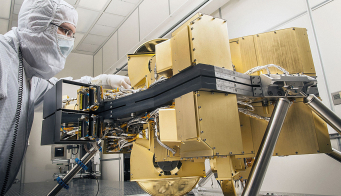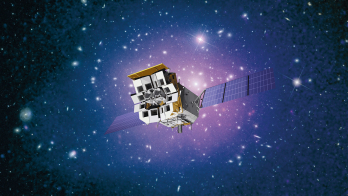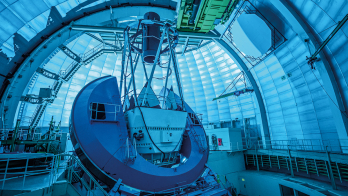
Credit: Mailseth.
What is the actual distribution of dark matter? Does it follow the expectations for cold dark matter (CDM)? “Yes, it does,” according to a team of astronomers that has measured the average distribution of dark matter derived from gravitational lensing in 50 clusters of galaxies. The density is observed to decrease outwards from the centre of these cosmic giants in excellent agreement with the predictions of CDM models.
While dark matter still eludes the scrutiny of particle physicists it is becoming more substantial to astrophysicists. Its gravitational role is essential to hold galaxies together in clusters, to account for the high rotational velocity of stars in the outer regions of galaxies and more generally to explain the formation of large-scale structures in the universe. The relatively recent ability to observe the distribution of dark matter in space makes it even more concrete (CERN Courier January/February 2007 p11). The method consists of measuring the slight distortion of background galaxies that is induced by the gravitational deformation of space–time along the line of sight. This so-called weak-lensing effect allows astronomers to locate and measure the amount of dark matter, even though it is transparent on the image.
The fluctuations of the cosmic microwave background as observed by the Planck satellite imply that CDM constitutes about 27% of the energy content of the universe (CERN Courier May 2013 p12). However, it is important to check whether the distribution of mass in galaxy clusters follows the expectations of a medium of dark-matter particles that only interact with each other via gravity and do not emit or absorb photons. An international team led by Nobuhiro Okabe of Academia Sinica, Taiwan, and Graham Smith of Birmingham University used a sample of 50 massive clusters of galaxies to test this. The clusters were selected from an X-ray catalogue in a narrow redshift range of around z= 0.2 and observed by the Prime Focus Camera of the Japanese 8.2-m Subaru Telescope located next to the two Keck Telescopes on Mauna Kea, Hawai’i. For each cluster, the team derived the weak-lensing signal imprinted in the shape of background galaxies and stacked the results to obtain the average density profile.
The obtained map of the mean dark-matter distribution is remarkably symmetrical with a pronounced central peak. The radial profile is found to be consistent with the Navarro-Frenk-White model at the sub-10% precision level. Measurement of the concentration parameter of the mass in the cluster gives c200 = 4.22 + 0.40–0.36, which is slightly above but still broadly in line with theoretical predictions for CDM. This result confirms that dark matter behaves in clusters of galaxies as expected by the CDM scenario. It solves a tension between previous observations of individual clusters that found a high central concentration and other studies that included the dynamics of the galaxies in the clusters and suggested a shallower distribution.
In the future, the team would like to improve this analysis by measuring the dark-matter density on even smaller scales right in the centre of these galaxy clusters. This will be possible with the installation of a new camera called the Hyper-Suprime-Cam on the Subaru Telescope, which will also allow astronomers to study smaller galaxy clusters, which are predicted to have a slightly higher dark-matter concentration. The team notes, however, that significant advances on the precision achieved in the current study on massive low-redshift galaxies are only expected with future facilities such as the Large Synoptic Survey Telescope or ESA’s Euclid Satellite.








